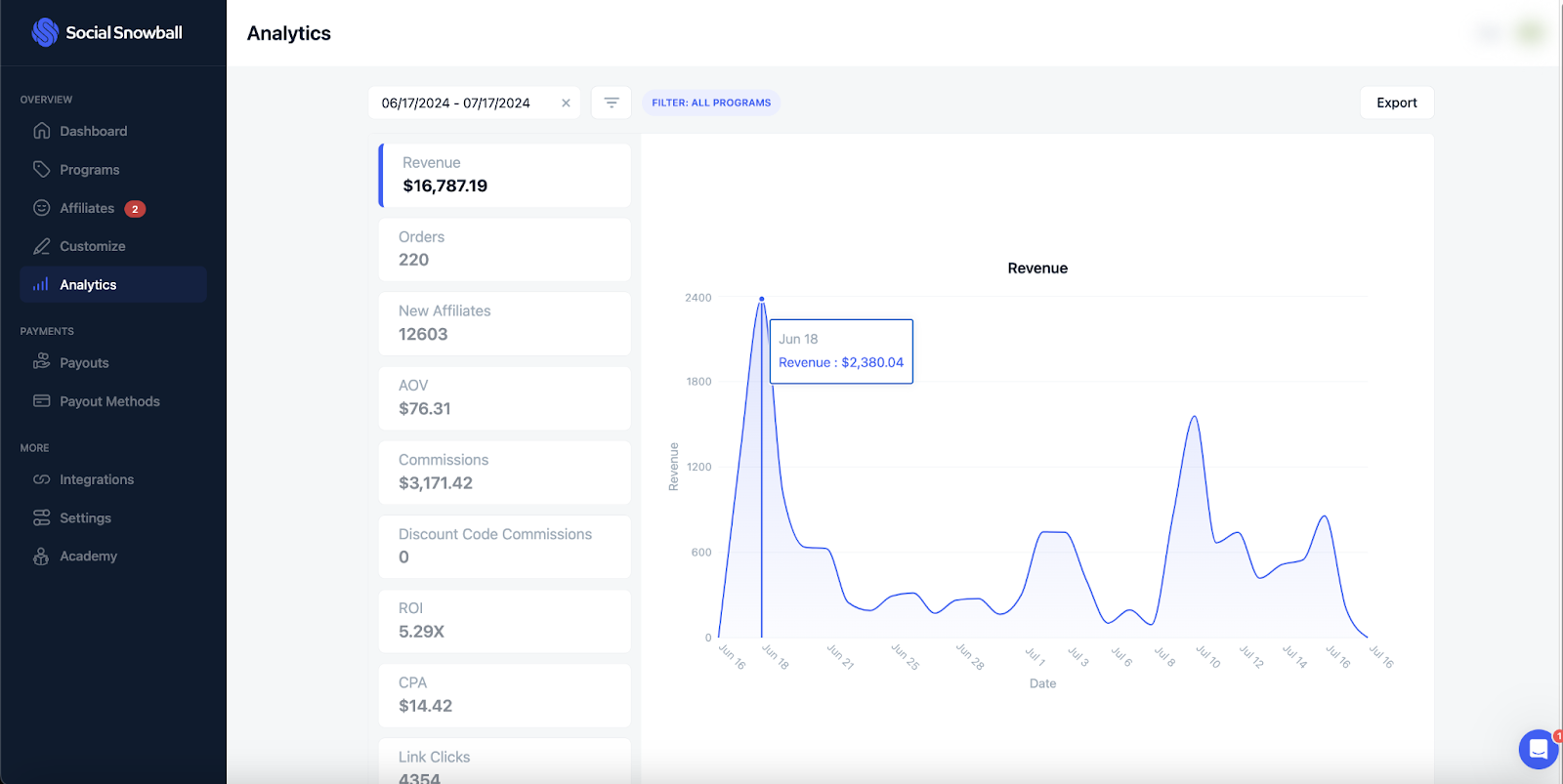Affiliate links are an important part of every performance-driven affiliate program. They track exactly which partner, post, or creator drove a sale, so brands can reward results, not guesses.
In this guide, we’ll break down what affiliate links are, how they work, and why they’re essential for ecommerce brands that want scalable, trackable growth.
What is an affiliate link?
An affiliate link is a unique URL that tracks when a customer comes to your store through an affiliate or creator. Every affiliate gets their own link, so when a shopper clicks it and makes a purchase, the sale is traced back to them.
Here’s what happens behind the scenes:
- A customer clicks an affiliate’s link.
- A tracking ID or cookie records that session.
- If that customer buys something, the system attributes the sale to that affiliate.
- The affiliate earns a commission automatically.
Each link acts as the bridge between your store and your affiliate’s target audience. It helps you see exactly who’s driving revenue, which marketing channels perform best, and how much commission each partner has earned without any manual tracking.

The structure of an affiliate link
A standard affiliate link is a tracking tool that connects every sale to the right affiliate. Here’s what it’s made of:
- Base URL: This is your product or landing page. For example, ‘www.brand.com/product.’
- Tracking parameters: Added to the end of the link, these parameters identify who referred the customer. You’ll often see something like ‘?ref=affiliate123’ or ‘?utm_source=affiliate_name.’
- Tracking ID or cookie: When someone clicks the link, a unique ID or cookie logs the session so your platform can trace the sale back to the right affiliate.

Together, these elements let you track who drove the sale, when it happened, and how much commission to assign.
But this setup has one flaw: static links and discount codes leak easily. Once a code ends up on a coupon site, anyone can use it, and the affiliate gets credit for sales they didn’t drive. That’s lost revenue and skewed performance data.
This is exactly what Social Snowball’s Safelinks fixes. Each Safelink dynamically creates a new, single-use discount code every time someone clicks an affiliate’s link.

Why affiliate links are important for ecommerce brands
Affiliate links make your program measurable, cost-efficient, and scalable. If you run a DTC brand, they’re the foundation of performance-driven marketing.
Here’s why they matter:
- You only pay for results: With affiliate links, you’re not guessing where your money goes. You pay commissions only when a sale happens through an affiliate’s link. Unlike paid ads, where costs rise regardless of performance, every dollar spent is tied to actual revenue.
- You know exactly what drives sales: Affiliate links give you a direct connection between content and conversions. You can see which TikTok creator, Instagram Reel, or blog post led to a sale. That clarity helps you invest in the creators and content formats that actually bring in revenue.
- You can scale without growing your workload: Once your setup is in place, you can onboard hundreds of affiliates without adding manual tasks. Affiliate tools like Social Snowball automate everything (link creation, tracking, and payouts) so your team can focus on strategy, not spreadsheets.
How to create and manage affiliate links
Running a successful affiliate marketing program starts with the affiliate link. These links connect your affiliate partners, content creators, and influencers directly to sales generated, making them the core of every performance-driven affiliate marketing strategy.
Here’s a step-by-step guide to set up and manage them the right way:
1. Choose the right affiliate marketing platform
Manually creating links for each partner doesn’t scale. Instead, use an affiliate marketing tool built for ecommerce brands, like Social Snowball, that automatically generates and tracks unique affiliate links for each partner. It syncs with your store in real time, auto-creates links post-checkout, and eliminates the need for manual setup.
The system should also sync with email marketing, TikTok, and YouTube, making it easy to manage all your affiliate campaigns from one place. This automation keeps your operations lean and your attribution clean.
2. Assign a unique affiliate ID to every partner
Every affiliate partner needs a trackable URL or affiliate ID that attributes each affiliate sale to the right person. This ID connects directly to your store’s landing page or product page, so every click, conversion, and payout is logged accurately.
This is what adds structure to your strategy. Without it, you’ll miss out on tracking commissions and conversion rates.
Tools like Social Snowball automate link creation and tracking, giving you accurate attribution without spreadsheets.

3. Use UTM parameters to track campaign performance
Add UTM parameters like ‘utm_source, utm_medium,’ and ‘utm_campaign’ to your affiliate links. This helps you understand which marketing channels (social media platforms, blogs, or email marketing) drive the most affiliate sales.

For example, if a company’s product review blog converts better than a YouTube video, you’ll know exactly where to optimize. This data-driven insight improves your conversion rates and helps you scale your affiliate campaigns strategically.
4. Integrate tracking for full visibility
Connect your affiliate system directly with your ecommerce platform to automate reporting, performance insights, and affiliate payouts. You’ll see which affiliate partners drive traffic and where your marketing efforts generate the most ROI.
Platforms like Social Snowball connect to your checkout, track all clicks, sales, and affiliate payouts in real time, and even prevent coupon leaks with features like Safelinks.
You can see at a glance:
- Which affiliates drive high-quality traffic.
- Which products perform best through referrals.
- How each affiliate campaign ranks across your marketing channels.
This data helps you double down on high-performing partners and optimize future campaigns.

5. Automate affiliate communication
Once your links are live, keep your affiliate partners engaged with automated, timely updates. Automated communication builds trust, keeps affiliates active, and saves your team from endless follow-ups.
Some ways to do this are:
- Send welcome emails with clear onboarding steps, terms, and agreement.

- Notify them instantly when they hit milestones or receive a payout.

Common mistakes brands make when using affiliate links
Even the best affiliate marketing strategy can fail if your link setup isn’t airtight. Many ecommerce retailers make small but costly errors that affect tracking accuracy, affiliate sales, and partner trust. Here are the biggest mistakes to avoid:
- Manual link creation: Building affiliate links manually slows everything down and increases human error. Mismatched IDs, broken parameters, and missing tags lead to inaccurate data and frustrated partners. Automating link generation ensures every affiliate gets a unique, trackable link instantly.
- Code leakage: Reusing static discount codes across multiple affiliates is one of the fastest ways to lose margin. These codes often end up on coupon sites, giving commissions to unqualified sales. Use single-use or dynamic links to keep tracking clean and protect profits.
- No incentive differentiation: A flat commission rate for everyone might seem simple, but it demotivates your best performers. Your affiliate partners (content creators, bloggers, and influencers) need tiered rewards, milestone bonuses, or exclusive rates to stay engaged and drive higher sales.
- Lack of link testing and optimization: Broken links, expired cookies, or missing UTM tracking can ruin your affiliate marketing campaigns without you noticing. Test links regularly, verify tracking across devices, and audit attribution data before every major push. Clean tracking keeps affiliates confident and ensures you’re paying for real results.
Best practices when managing affiliate links
Managing affiliate links correctly keeps your tracking clean, payouts accurate, and affiliate network strong. Here’s how to do it right:
- Use single-use links and codes: Static codes are easy to leak and hard to control. Switch to single-use links, like Social Snowball’s Safelinks, so every shopper gets a fresh, one-time code. It protects your margins and keeps attribution locked.

- Centralize tracking: Don’t juggle multiple spreadsheets; instead, manage all affiliate data, clicks, conversions, and payouts in one dashboard. Centralized tracking helps you spot top performers faster and fix underperforming campaigns before they cost you.
- Pair links with performance bonuses: Use your affiliate data to identify top earners and reward them. Offer higher commissions for hitting volume, conversion, or AOV milestones. Performance-based bonuses motivate affiliates to keep posting and drive consistent revenue growth.
- Integrate with TikTok Shop and creators: Track performance directly from content to conversion. Integrations with TikTok Shop, YouTube, and creator tools help you see which videos or posts actually drive sales and invest more in the creators that perform best.
Run a trackable affiliate marketing program!
The right platform helps you turn every affiliate link into measurable revenue without the manual work, coupon leaks, or tracking errors.
Want to manage affiliates, influencers, and referrals from one dashboard? Social Snowball gives you all the features you need— automated link creation, one-click payouts, code protection, and real-time tracking across every channel. Some of the best affiliate programs, like Buoy have generated $400K of affiliate revenue in 12 months using the tool.











